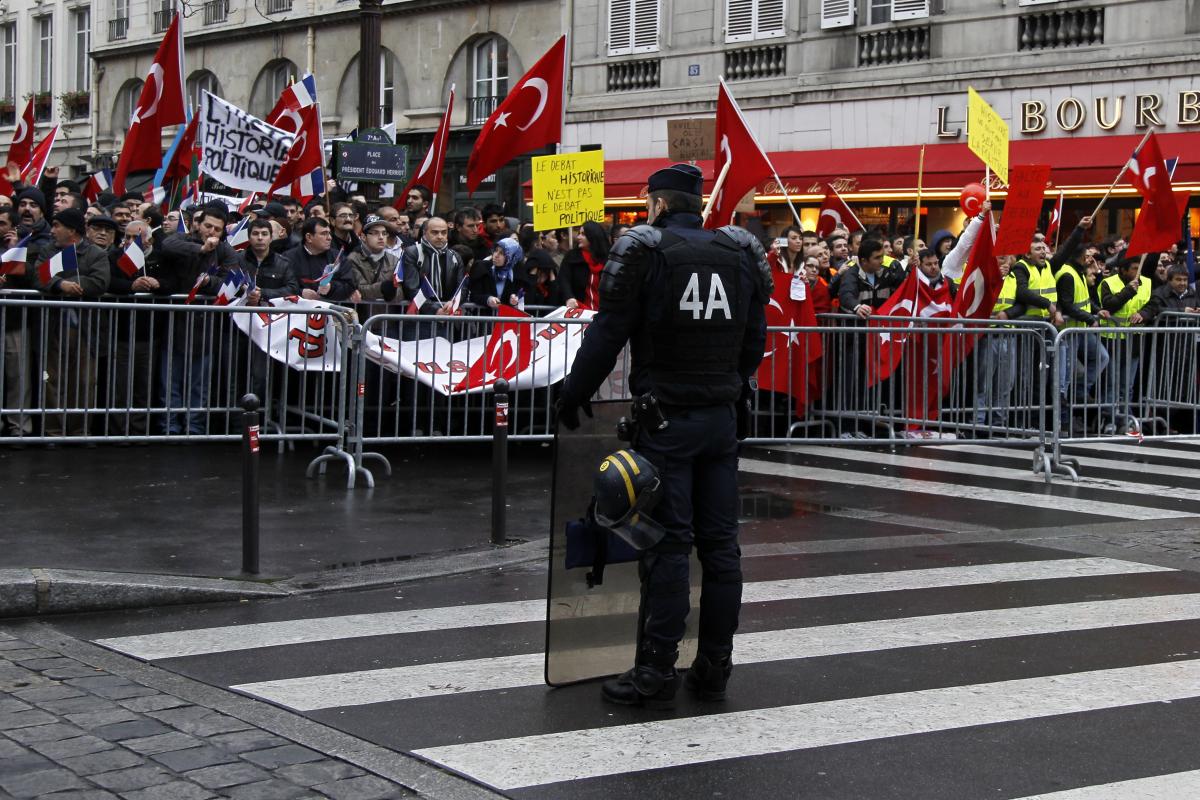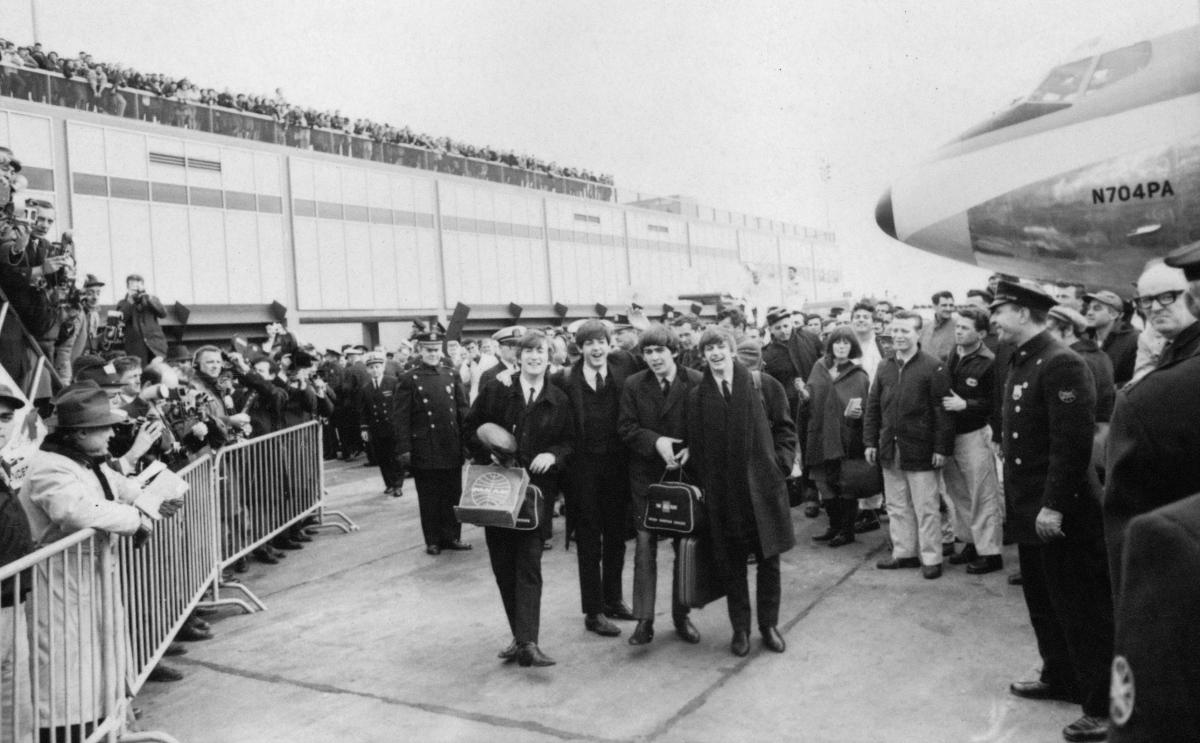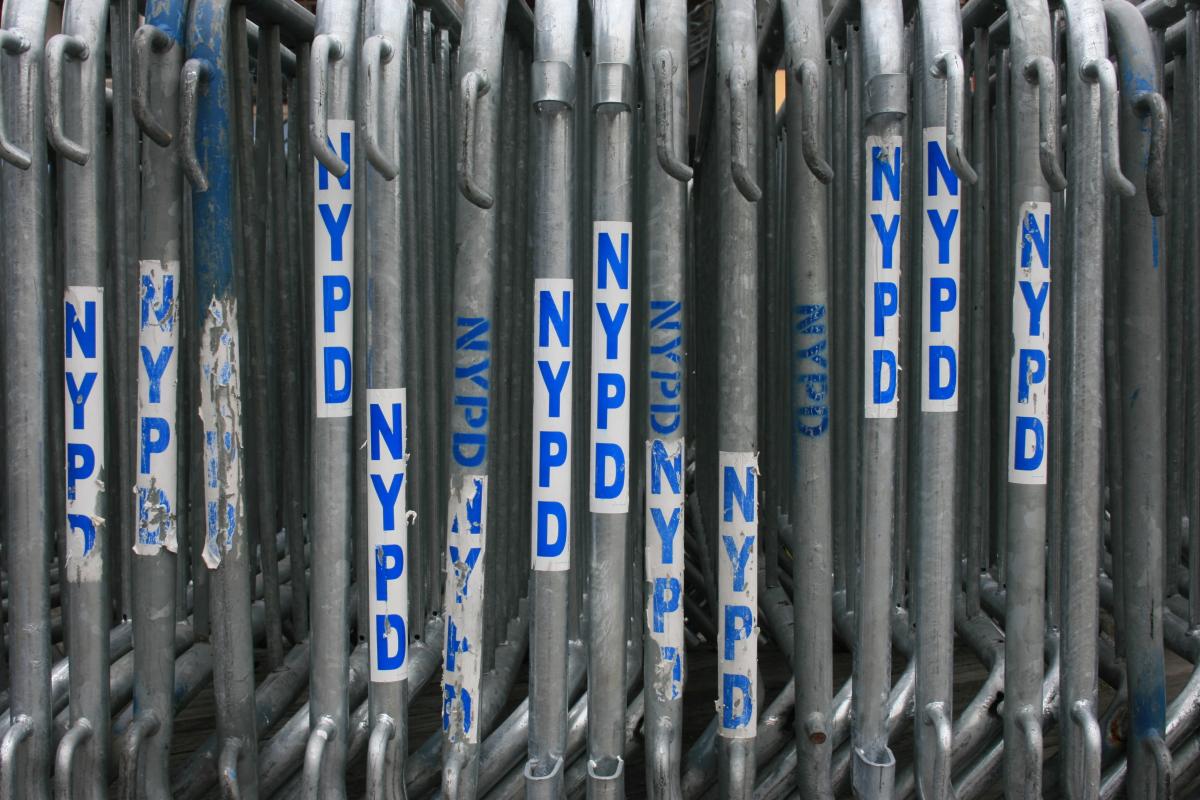Portable Boundaries
They are deceptively simple in design and so commonplace in our cities that we pass by them without giving them a second thought. But once they are deployed, they provide an extraordinarily effective means of crowd control, permitting even small forces to contain and control large masses of people with relatively little effort.
Cover photo: French barriers deployed at Gorky Park in Moscow at a sporting event. The design of the interlocking barriers connects units in such a way that only the last one is easily removable due to a bend in the top hook, which enters the receiver at an angle of about 30 degrees. Thus the units can only be connected and disconnected when they are at right angles to each other. (Photo: Peter Biľak)
Although my neighbour Rebecca was nine months pregnant, she went to Manhattan on February 15th, 2003 to join the demonstration against the Iraq War. The estimated 300,000 protesters who converged on New York’s East Side that day had been denied a marching permit a week earlier by a federal judge who cited heightened security concerns in the wake of 9/11 and authorised only a stationary assembly on 1st Avenue. En route to the demonstration, Rebecca and thousands of others were gradually herded onto 2nd and 3rd Avenues by New York City police and found themselves confined within a corral of interlocking steel barricades. Rebecca eventually pushed her way to the edge of the crowd to plead for release, but others on the same block found themselves trapped in their impromptu prison for up to six hours in freezing temperatures. Unable to leave, many had no choice but to relieve themselves in the street; some collapsed from exhaustion.
Compared to recent demonstrations in places like Istanbul, Cairo or Damascus, this barely registers as mistreatment. No protesters were killed that day, and while some sharply criticised the containment tactics of the New York City Police Department (NYPD) afterwards, there were few acts of overt brutality. What set the Iraq War protest of 2003 apart from those that came before it, at least in New York, was its asymmetry: just 5,000 police officers were able to restrain approximately a quarter-of-a-million citizens against their will, mostly without touching them or even talking to them.
The innovation that made this possible dates back to 1951, when a French company called Samia SA began manufacturing a patented steel barricade to address the shortcomings of existing wooden ones. Besides being lighter and faster to deploy, the ‘Samia barrier’ boasted two remarkable features. First, the steel bars that formed the bulk of the barrier were oriented vertically, making it surprisingly difficult to climb. Second, it could lock together with adjoining barriers in a way that defied easy separation. Two downward-facing hooks at one end could be dropped into two slot-like sleeves at the end of another; a 30° kink in the upper hook meant that the two had to be at right angles to each other for this to occur. Once assembled and straightened, the only way to separate two barriers was to rotate them back to a 90° angle and lift—something nearly impossible to do in a dense crowd.
You seem to enjoy a good story
Sign up to our infrequent mailing to get more stories directly to your mailbox.The Samia barrier was developed and patented during the social upheaval of the 1950s in France. More effective than wooden sawhorses and requiring far less manpower than police cordons, it has become a popular method of crowd control all over the world.

On February 15, 2003 a hundred thousand protesters gathered for a demonstration on First Avenue in New York City to express their opposition to the imminent Iraq War. The New York demonstration was one of hundreds that took place on the same date in cities around the world, forming the largest protest event in human history. (Photo: Mario Tama / Getty Images)
Except for a few small tweaks, the Tamis ‘Blockader’ barricade used by many police departments today, including the NYPD, is identical to the one made by Samia 60 years ago, which makes it something of a modern design classic. Durable, simple and profoundly effective, the ‘French barrier’ (as it’s commonly known in the US) allows a small group of people to exercise authority over a much larger one, directing their flow, denying them access to prohibited areas, or restraining them.
This gives it a powerful emotional impact. Being barricaded in can be genuinely terrifying, which is exactly the point: a crowd that feels afraid and impotent is easier to control. Despite this, I can’t help admiring the ingenuity that makes it possible. A 30° bend is such a subtle thing, yet it transforms the barrier from something that indicates a boundary, like a velvet rope or police line, into something that enforces it.

A French riot policeman faces Franco-Turk protesters during a demonstration in Paris on December 22, 2011 preceding a parliamentary vote on a bill that would make it a crime to deny that the 1915 mass killing of Armenians by Ottoman Turks was genocide. These interlocking barriers, patented in 1951 in France, were designed to allow a relatively small force to control large crowds. (Photo: Charles Platiau, Reuters/Novum)
French barriers were largely a European phenomenon through the 1960s and 1970s, and New York didn’t truly embrace them until after 2001, making Rebecca’s experience a relatively novel one. The NYPD had mostly employed large wooden sawhorses for crowd control until then, explains Deputy Commissioner Paul Browne. They can still be found scattered through the city, recognisable by their bright blue colour and stencilled white text, but as Browne points out, ‘They’re fine if people respect that they say “Do Not Cross”, but you can get under them pretty easily.’
All that changed with 9/11. Beyond the immediate physical damage, the World Trade Center attacks also left New York with a weakened economy that translated into a shrinking police force. ‘In 2001, we had 41,000 officers,’ says Browne, ‘But as people moved out, we couldn’t replace them […] By 2002 we were down 5,000 cops, plus we had a new counterterrorism unit to staff.’ On top of this, dozens of organisations, in an attempt to show solidarity, had elected to bring their major 2002 conventions to the city, giving the NYPD twice the normal number of demonstrations to control. ‘We had groups like the World Economic Forum and the Republican Party deciding to have their conventions here,’ recalls Browne, adding that intelligence was also indicating a growing al-Qaeda presence in the city. ‘So in addition to Seattle-type demonstrators,’ he explains, alluding to the riots connected with the World Trade Organization’s 1999 conference, ‘there was a real concern about terrorist attacks.’
Variations on the original Samia barrier can be seen in concert venues and sports stadiums, at festivals and demonstrations, around construction sites and parade routes: in short, nearly anywhere that crowds need to be directed, restricted or contained.

One of the earliest uses of French barriers in the USA was to control the hysterical crowds that gathered in New York City for the arrival of the Beatles in 1964. In America, steel or aluminium crowd- control barricades have only come into general use in the last decade, replacing wooden sawhorses. (Photo: CBS/Getty Images)
Under these circumstances, French barriers offered a welcome solution. Their construction made them difficult to compromise, and their ability to form interlocking lines reduced the number of officers needed to police a demonstration. Unlike sawhorses, which rely on active enforcement, French barriers control crowds silently and require fewer personnel. ‘We now have about 25,000 of them,’ says Browne, ‘and most of that is since 2002.’ Today the department maintains a vast warehouse in Queens where thousands of barriers wait in tight, orderly rows for deployment via a small fleet of dedicated flatbed trucks.
In the rare cases when a stampeding crowd manages to topple one, a barrier line can turn suddenly hazardous. Its ladder-like bars can easily entangle the ankles of the unwary; its feet, poised around groin level, become dangerous impalement hazards. For this reason, the websites of barrier manufacturers and government agencies are filled with detailed discussions of anti-tipping measures. Some recommend sandbags. Others replace the sharp-ended feet with less dangerous steel plates.
Despite these dangers, French barriers have become a fact of life wherever people gather in high densities. They’re a fixture not only at demonstrations, but also at music festivals, sporting events and parades. Recently, across the street from the building where Rebecca and I lived, an NYPD captain lined a bike lane with French barriers to keep police cruisers from parking in it, giving bike riders a safer alternative to riding amongst trucks and cars. The move has been praised by local cycling groups as an example of effective cooperation between police and the communities they serve.
With the help of these efficient interlocking barriers, a few people can control much larger groups of people.

NYPD has leased a 118,000 square feet (10,962m²) storage in Long Island City to store thousands of barriers designed for crowd control. The Tamis ‘Blockader’ barricade used by NYPD is part of the reason why the number of officers has been significantly reduced in the past decade. (Photo: Christopher Penler)
Taken together, these uses demonstrate that despite its capacity to be used for fear and manipulation, there’s nothing inherently evil about a French barrier. Like a hammer, a mobile phone or a knife, it’s a highly functional tool that does exactly what it is designed to do, enforcing the will of its user efficiently and without judgement.
But tools also have practical limits, and their very neutrality means that anyone who understands their workings can potentially thwart or re-appropriate them. In the case of French barriers, being aware of their presence and installation is a good start. Even better is knowing how to remove them should the need arise: rotate, then lift, starting from the end of the line.

